Register ATS Inspect in ATS Security
Before starting the installation, ATS Inspect needs to be registered in ATS Security.
ATS Inspect 7 requires ATS Security v1.8.23149.1 or above.
Browse to the ATS Security URL and login with a user that has rights to edit applications.
Click the Security card and press Open.

Click the Applications card and press Add Application.
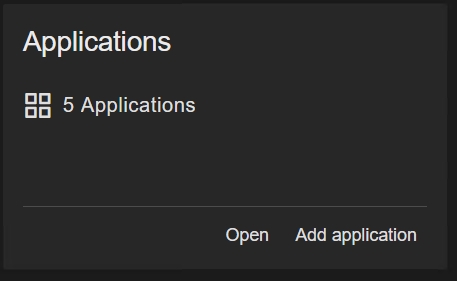
Enter the following information about the new application:
Name: Enter a name for the application, for example ATS Inspect.
The name assigned to the application must be unique within ATS Security.
Description (optional): Enter a description for the application that can be seen in the applications grid card.
Application logo and/or background image (optional): Upload a logo image and/or background image for the application.
Press Add and edit.
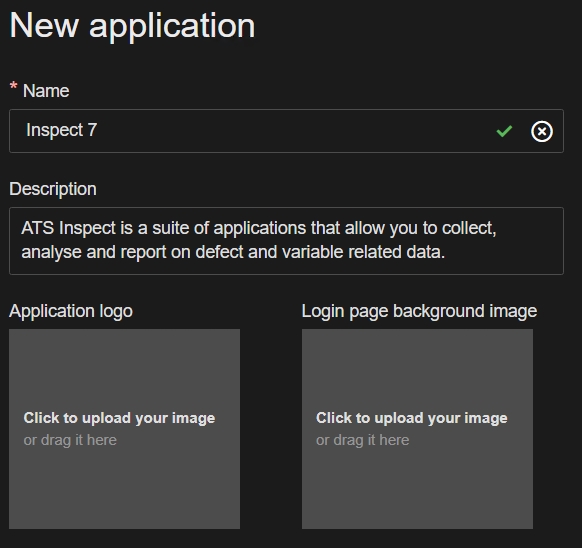
If the application was added successfully, the pane will refresh and feature a new Application Id field and the Application status field will display Created.

Acquire Application ID for ATS Licensing application
During the installation of the ATS Licensing Server services, an Application ID is required. To obtain the Application ID, hover over the Application Id field and copy the string by pressing the the copy  icon.
icon.

Install ATS Inspect - Server Setup Wizard
This section describes the installation of ATS Inspect Server. This installs the required services as well as the Connectivity Kit which allows you to create and update databases.
Should a previous version exist, it must be uninstalled before proceeding.
You must run the Inspect installation with administrative rights. In Windows 10 and above you must also have elevated rights.
Run the ATS Inspect - Server.exe.
If the prerequisite applications, .NET Desktop Runtime 8 x64 and ASP .NET Core Runtime 8 x64, are not installed the screen below will be displayed. If all prerequisites are installed, please proceed to step 4.
Press OK and then Finish.
Install the latest .NET Desktop Runtime 8 x64 and ASP .NET Core Runtime 8 x64 and then re-run the installer.
Press Next.
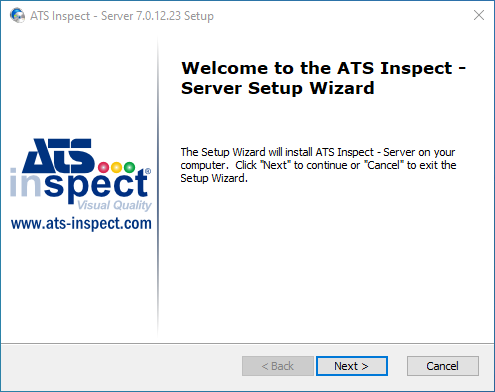
Select I Accept the terms in the License Agreement and click Next to proceed.
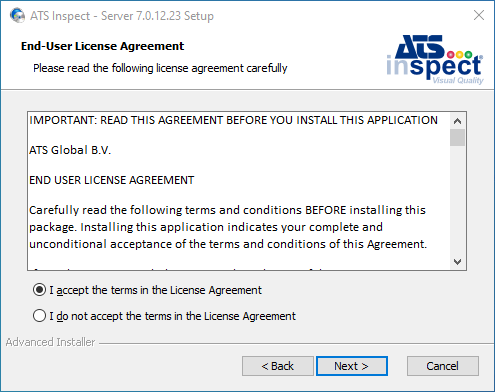
Select one of the following installation types:
Complete - All program features will be installed..
Custom - Allows users to choose which program features will be installed and where they will be installed. Recommended for advanced users..
The installation location can only be changed by using a Custom installation.
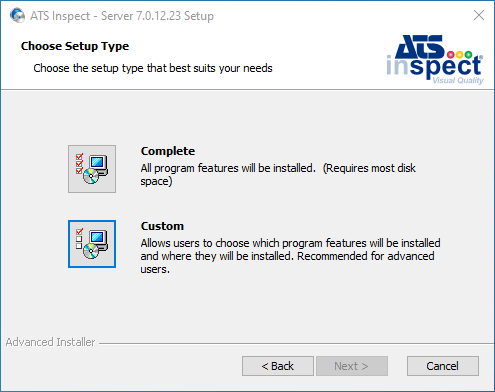
If you click Custom the following screen is shown.

Change the installation location by clicking Browse and selecting the installation folder.
Select the required components as listed below.
Services includes the following items:
Data Service: Handles requests to deliver data to various Inspect clients and services. It acts as a gateway between the database and the Inspect applications in order to keep data access consistent.
Communication Service: Processes Inspect-related data received from Flat files, RS-232 and TCP/IP sockets.
Travel Service: Processes travel ticket requests.
CAD Services
CAD Report Service: Provides functionality used by Inspect modules needing images from CAD.
CAD Conversion Service: Map between Inspect Image ID and stream cache model name.
Event Service: Alarm notifications.
Connectivity Kit: Scripts to create or upgrade databases.
Services should be configured to start as follows:

The above image represents the recommended approach of installing SQL and Inspect Server on separate servers. If SQL is installed on the same server as Inspect then all services should be set to Automatic Delayed Start but this is not recommended.
Click Browse to select a different installation location.
Click Next.
Enter the Security Manager endpoint in the Endpoint field using the full FQDN and port number. I.e. https://hostname.domain:5000.
Enter the Application ID. See section Acquire Application ID for ATS Licensing application.
Press Next.
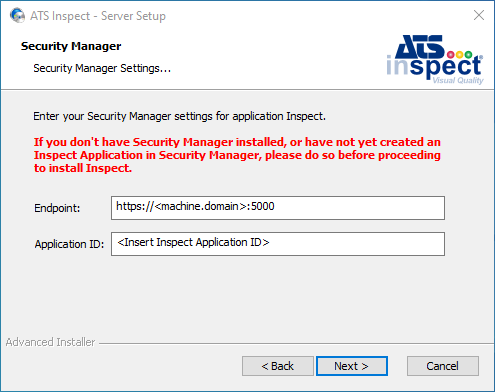
Select a certificate to enable the encryption of traffic in the Certificate field. The Subject field will automatically populate with the subject from the certificate.
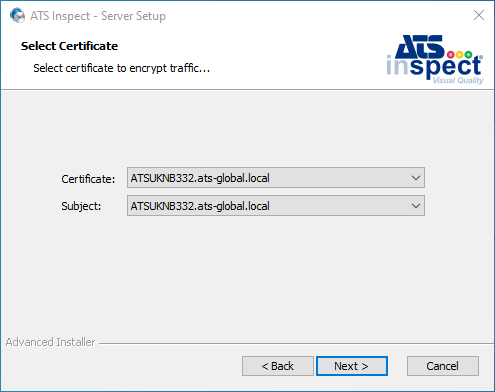
For further information on certificates, please refer to Create and register certificates for TLS/SSL.
The Inspect Database configuration screen is displayed.
Enter the required details.
Server: Name of the Server where Inspect Database resides (e.g. ATSSERV022\SQL2022)
Database: Inspect Database Name
Username: Database Login
Password: Database Password
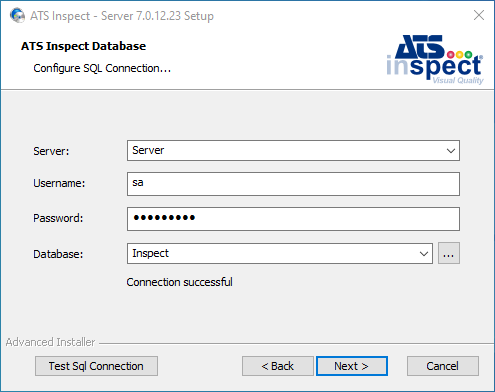
If required, click Test SQL Connection to check your settings.
Click Next.
Enter the FQDN of the server that hosts the Data Service.
Enter the base port of the service. The default is 8500.
Enter the FQDN of the server that hosts the other services if different from the Data Service.
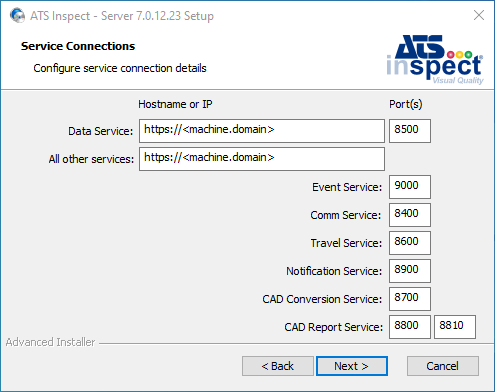
Press Next.
The Ready to Install dialog is displayed.
Click Install. Inspect begins to install. This may take several minutes.
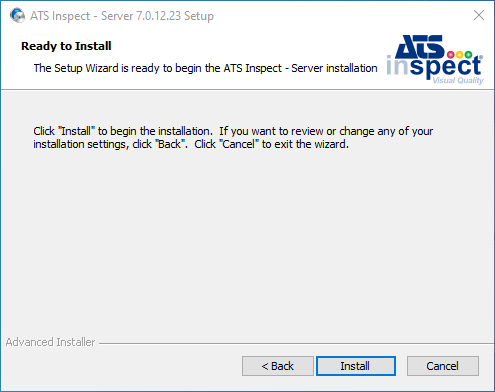
When the installation is complete place a tick in the View readme file checkbox if you wish to view information about the latest updates, otherwise click Finish to close the installation program.

Start the Data service using by running services.msc.
The application status of the Inspect application in Security Manager will change from Created to Configuration uploaded.
If you are using an existing database you will now need to update it so that it is compatible with this version of Inspect. For further information see here.
Command Line Options
The following command line options can be specified when running the Inspect Server installer from the command line. Their values will be written to the .config files of the relevant applications and will be used when running the application:
|
Option |
Description |
Default Value |
|
SERVER_PROP |
The hostname/IP of the database server. |
192.168.56.1 |
|
DATABASE_PROP |
The name of the Inspect database. |
InspectMain |
|
USERNAME_PROP |
The database user's name. |
sa |
|
PASSWORD_PROP |
The database user's password. |
|
|
SEC_MAN_ENDPOINT |
Security Manager Endpoint |
|
|
SEC_MAN_APP_ID |
Inspect Application ID in Security Manager |
|
|
DATASERVICE_ENDPOINT |
The hostname/IP that Data Service will run on. |
localhost |
|
DATASERVICE_PORT |
The port that Data Service will run on. |
8500 |
|
SERVICES_HOSTNAME |
The hostname/IP that all services, apart from Data Service, will run on. |
[Computer Name] |
|
EVENTSERVICE_PORT |
The port that Event Service will run on. |
9000 |
|
COMMSERVICE_PORT |
The port that Communication Service will run on. |
8400 |
|
TRAVELSERVICE_PORT |
The port that Travel Service will run on. |
8600 |
|
NOTIFICATIONSERVICE_PORT |
The port that Notification Service will run on. |
8900 |
|
CADCONVERSIONSERVICE_PORT |
The port that CAD Conversion Service will run on. |
8700 |
|
CADREPORTSERVICE_PORT |
The port that CAD Report Service will run on. |
8800 |
|
CADREPORTSERVICE_BACKEND_PORT |
The port that CAD Report Backend Service will run on. |
8810 |
To perform an unattended Inspect Server installation, run the following command line as an administrator:
"ATS Inspect - Server.exe" /qn SERVER_PROP="192.168.0.1" DATABASE_PROP="Inspect" USERNAME_PROP="sa" PASSWORD_PROP="pwd"
Replace the values in the above example to match your configuration.
For further information on command line options, please click the link 
Select features to be installed from the command line
In addition to the options listed above, the ADDLOCAL property can be used to allow users to select which features to install. The table below details the values to be used, which can be separated by commas.
|
Identifier |
Description |
|
DatSvc |
Data Service |
|
ComSvC |
Comm Service |
|
TrvSvc |
Travel Service |
|
TrvPrntSvc |
Travel Print Service |
|
RptSvc |
Report Service |
|
CnvSvc |
CAD Conversion Service |
|
EvtSvc |
Event Service |
|
NtfSvc |
Notication Service |
|
DTW |
Data Transfer Wizard |
|
LT2GDI |
LeadTools to GDI Converter |
|
LoginDemo |
Login Demo |
|
ConnKit |
Connectivity Kit |
For example, to install the Data Service and Data Transfer wizard, the following command could be executed:
"ATS Inspect - Server.exe" /qn SERVER_PROP="192.168.0.1" DATABASE_PROP="Inspect" USERNAME_PROP="sa" PASSWORD_PROP="pwd" ADDLOCAL="DatSvc,DTW"
Configuration of roles for ATS Inspect
After the successful installation of ATS Inspect the status of the registered ATS Inspect application in ATS Security should be set to Configuration Uploaded. This indicates that the ATS Inspect application rights have been uploaded to ATS Security and can be assigned to ATS Security roles, which in turn can be assigned to users.
For a complete list of available security rights for Inspect, please click here.
For more information on creating and managing user accounts, please visit the ATS Security online help here.
Create an ATS Inspect role
Create a new role in ATS Security i.e. InspectAdmin. For further information on creating user roles, click here.
Select the Rights tab and expand the ATS Inspect application list.
Assign all permissions to the new role. For further information on editing roles, click here.
Assign the new role to a user that can authenticate through ATS Security such as an admin user. For further information on editing users, click here.
Alternatively, assign all permissions to an existing admin role.
Users assigned with the new permissions are required to log out and sign in again for the changes to take effect.
The user and role configurations are completed. The user can log into ATS Inspect using the Admin account.